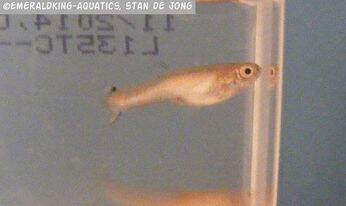Hybrids
In this section I'd like to show you certain interesting natural mutations and hybrids of livebearers which have been born overhere. These fish haven't been linebred further on by me.
In order to create a hybrid between two different livebearer species, it's important to know how close their DNA match with another. And their sexual organs should be compatible. If these two criteria don't meet up, there's no chance that a hybrid between two different livebearer species will be possible (at least, in a natural way that is).
There are hybrids that are fertile and there are hybrids that are infertile. There's one main reason why a hybrid will be fertile or infertile. For sexual reproduction, the sperm and egg must each have 50% of the chromosomes. Which means that the number of chromosomes of both parents must be even in number. So, the number of chromosomes of the offspring will also be an even number. In that case, the offspring will be fertile. Will the number of chromosomes be an odd number, the offspring will be infertile. This odd number means that the genetic code will not work for reproduction. But there are some exceptions. But these exceptions equals a small percentage...
Below we have some interesting hybrids. These were born in 2010 and were born from an interbreeding of a male Micropoecilia parae melanzona var. red x a female flare endler. This proves that an interbreeding with a far related species of the the endler is possible. They also turned very fertile despite of the relationship to the endler as already mentioned. My apologies for the blurred photos for the quality of the camera at that time wasn't too well. But I needed prove for this interbreeding and took the shot.

The pictures show two males. The blond body is definitely recognizable as being the flare endler. The body shape is slender and stretched like the M. parae. Also the red lining on their bodies and the typical flame which goes upwards in the tail is similar to the M. parae. The bottom sword is typical an endler specification.
They were crossbred with their sisters and only grey offspring were born. The males which developed had the same build and red lining just like these two. And so, yes... they were really fertile!
I've also crossbred a male Micropoecilia picta (wild colour) x female black bar endler in 2007. The female offspring were exactly like female endlers. The male offspring were a bit more slender and the pattern of a M. picta and a huge amount of emeraldgreen and purple in them. A peacock on their tails and back. Unfortunately, I've never made any pictures of them. At that time I wasn't focused on doing that. My focus was just to breed those fish... But again, becoz' of this I am so convinced that more interbreeding are possible between different genus'. For a lot of theories are based on "how big are the odds that an actual interbreeding between two different genus' is possible?". The answer which will be given will probably be 0%. A very easy answer but it doesn't cover the question what I've noticed...
Even a molly can interbreed with a guppy for that matter. It's not likely that an interbreeding will just happen if you put two different livebearers together. But in case it's a deliberate project to do so, it's really possible. Also when a male of some kind of livebearer will be left alone by his own species, there's a chance that he might impregnate a different species. For sure, it will be the question wether the offspring is strong enough or even fertile. But an interbreeding between different species does not automatically mean that the offspring will be unfertile (as stated above).
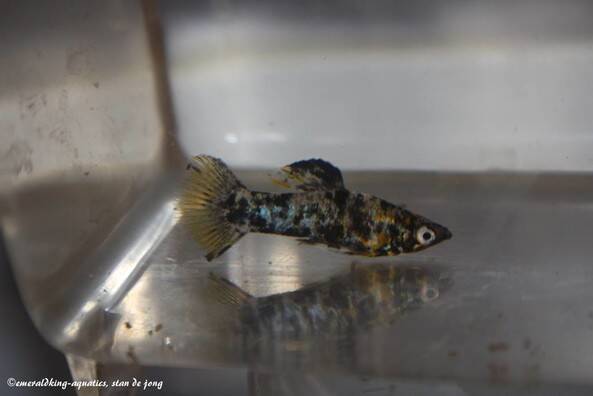
Above:
A male offspring of a cross between male guppy (Poecilia reticulata) x female marble molly (Poecilia sphenops). Look how slender this specimen is. Crosses like him are called a "Muppy" or a "Golly
What's the difference between a golly and a muppy?
A golly is a cross between a male guppy and a female molly. A muppy is a cross between a male molly and a female guppy.
I do have to say that such offspring between a molly and a guppy may differ in phenotype (body shape, fin shape, color and pattern). For it depends on what kinds of phenotypes you'll be using as parents. If you'd establish such a hybridization, preferably to use a male guppy x female molly. A female molly has got less problems if the offspring turn out to be large at birth in comparison to a female guppy.
Below:
Another male hybrid between molly x guppy but this specimen is less slender. The back of the caudal is round shaped. Which he most likely has inherited from the guppy influence.
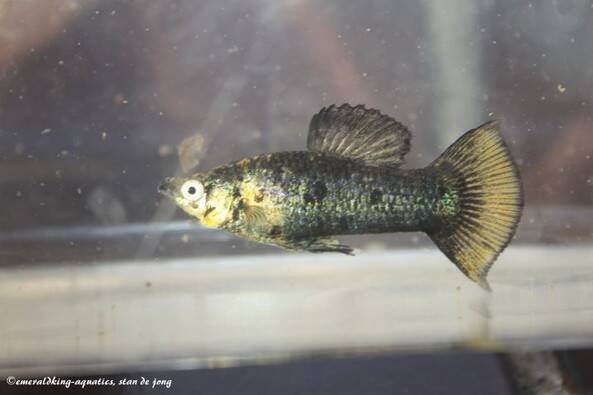
Below: Also a young male molly/guppy hybrid starting to develop his gonopodium (photo left).


Below:
Overhere a number of pictures of crosses between molly and guppy. The following pictures are specimens of another breeder (Furui Muppy) and with his permission, I'm allowed to post his fish. You can clearly see that also other colors than the one I've shown of my own are possible.
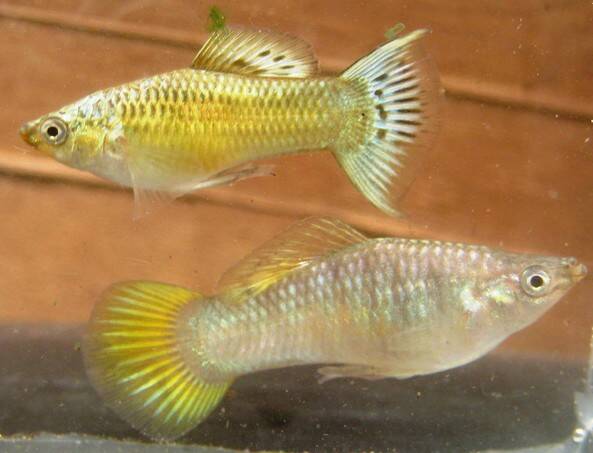
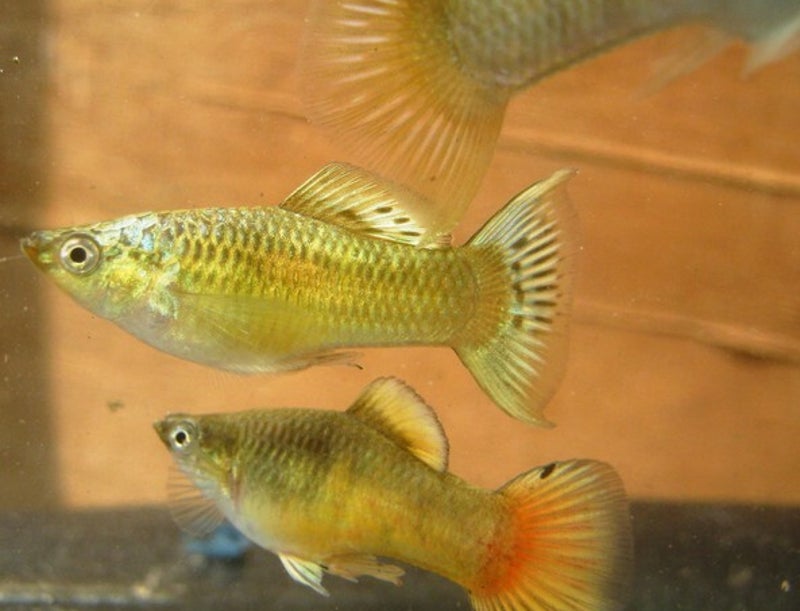
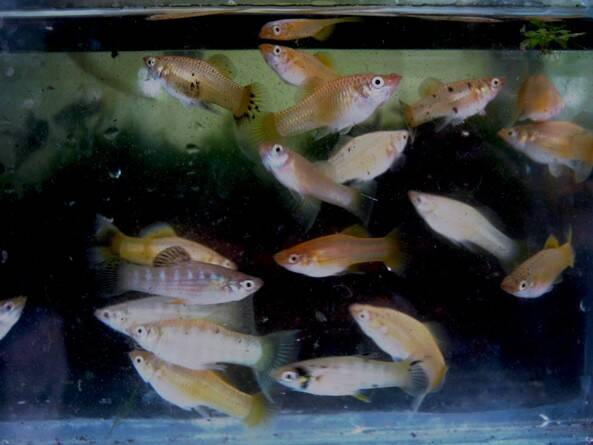
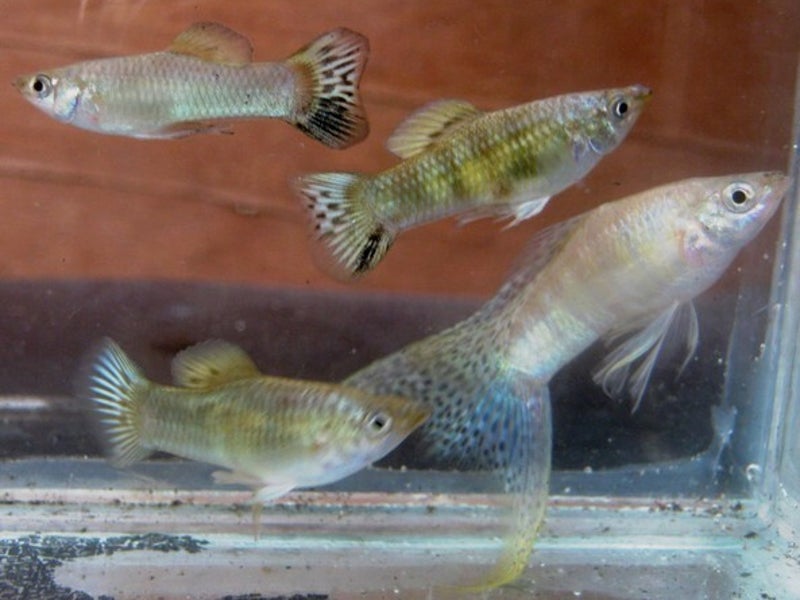

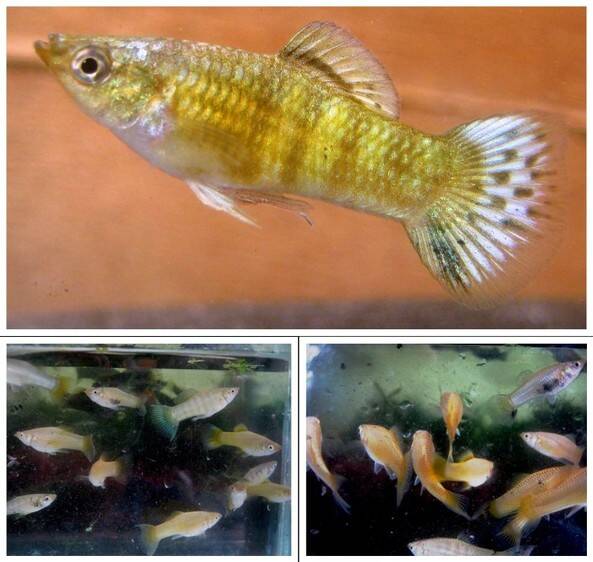
The pictures shown above of a guppy/molly cross, shows such a diversity of colors and pattern. But again, the phenotype of such a hybrid depends on what kind of molly and what kind of guppy has been used. So, such a cross can even look different than the ones shown.
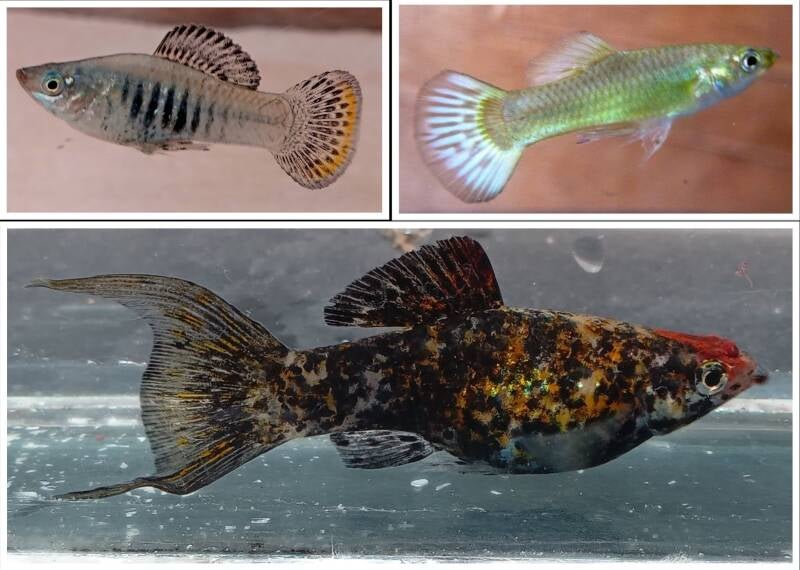
Above: a female marble tancho lyretail muppy. A female koi guppy has been used to create this.
Below:
Left photo: Two cousins blond albino cousins (male golly & female guppy). Their mothers are sisters.
Right photo: A female guppy and her muppy fry.

Below: Muppy fry.

Below:
A 3 year old male golly. Typical is his dorsal that reflects the guppy influence. The striping in his dorsal shows that his mother was a Poecilia latipinna (picture by Carter52).

Furui Muppy has proven that a cross between molly and guppy "can" be fertile. Unlike a lot of other people claim to be. He has successfully bred F2 generation by backcrossing.
Well, I've got one late male that survived from a cross between a female black cobra hybrid endler (own created strain) x male Limia perugiae. The body shape is more guppylike but it's a large specimen. It seems that he's got the size of his father. The dorsal has a shape between a male black cobra endler hybrid and a male Limia perugiae. If I would use a nigrocaudatus or moscow female guppy (includes endlers as well) to cross to a non nigrocaudatus or moscow male guppy, the male offspring would have a dark body. But in case of crossing such a guppy to a Limia perugiae was an unkown path to me of how the nigrocaudatus or moscow gene would be passed on. Using warm white light, his body looks dark but more greyish than black. Ijn sunlight, he seems more greenish. His caudal shape is a shape is definitely a cross between the caudal of this Limia species and the double sword of the black cobra hybrid endler. Crossing a female endler/guppy of a double sword tail x a closed male Limia perugiae tail shape, will result in a closed tail with raffles.
The grey with greenish metallic shine of the Limia perugiae has made the dark color (coming from the black cobra endler hybrid) lighter. And the greyish/greenish of the Limia perugiae seems dominant in this case. The moscow gene that the black cobra strain carries was of less influence in this case. This 3 inches sized male hybrid has showed his sex quite late. For the body shape itself looks more feminine than masculine if we compare it to regular guppies. Males of the black cobra hybrid endler strain only max out to an inch or just over. And they look way different. if one would see this male for the first time, it resembles a huge male guppy. But in the black cobra line of mine, no guppy strain was used which resembles this phenotype.
This male also shows this black mark in the dorsal which my male Limia perugiaes has. But the black mark is to be seen in the lower part of the first finrays while Limia perugiae specimens have it in the lower part of the last fin rays. Also the color of caudal seems yellowish in the middle (Limia perugiae does show some yellow in the caudal when the light hits the caudal), some white on some almost outer fins rays. The cobra pattern in the fins of the black cobra is lacking in this male.
So again, this only left male has got the bodyshape of a large guppy (female shape & 3 inches), body color → greyish/greenish (slightly tuxedo), the black mark in the dorsal of the Limia perugiae, And if he's in rest, you do see that he's got a nice chest (smaller than the L.perugiae and bigger than the black cobra endler hybrid).
I do have to say that hybrid between a Limia x guppy/endler or a molly x guppy/endler may all look different depending on what type of Limia, molly or guppy (includes endlers) are used.
This crossbreed happened by accident. I've kept a donated male L.perugiae in a small tank with two small and young black cobra females which I wanted to keep as virgins. Apparently, the male bred with one of these three females. Only one got pregnant and the other two were used for a different purpose. Once pregnant I've put her separate from other fish. She gave birth to just a small number of fry (6 to be precise). 5 have died along the way and just one survived. This specimen grew pretty fast and despite of the fact that I didn't see a gravid spot, it has a female guppy shape (but more stretched). I also have to mention that female L.perugiae also hardly show a gravid spot till even none (same as in female mollies). So, I still wasn't able to determine the sex. At almost 3 inches, the anal fin turned into a gonopodium. Something that does happen frequently in male L.perugiae specimens as well that a gonopodium will be formed when they're at adult size. If this male is fertile is something I have to wait for. It's not sure if such hybrids will definitely be infertile despite of the fact that they're two different genera.




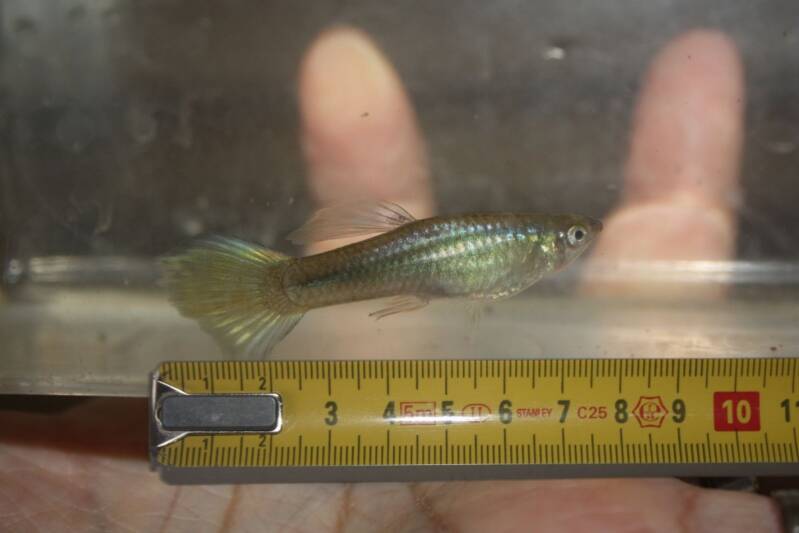
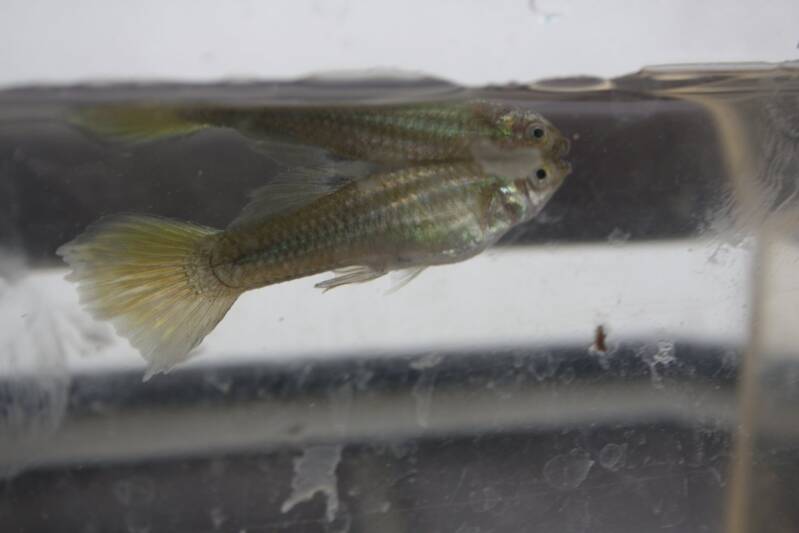
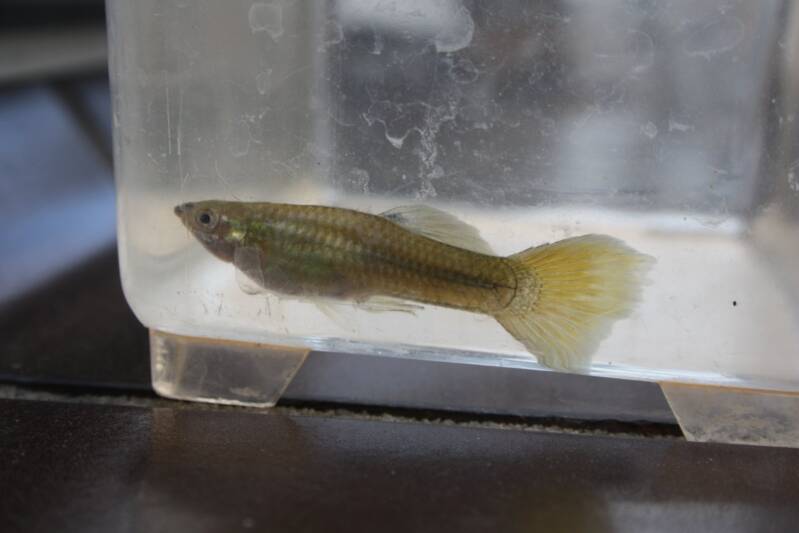
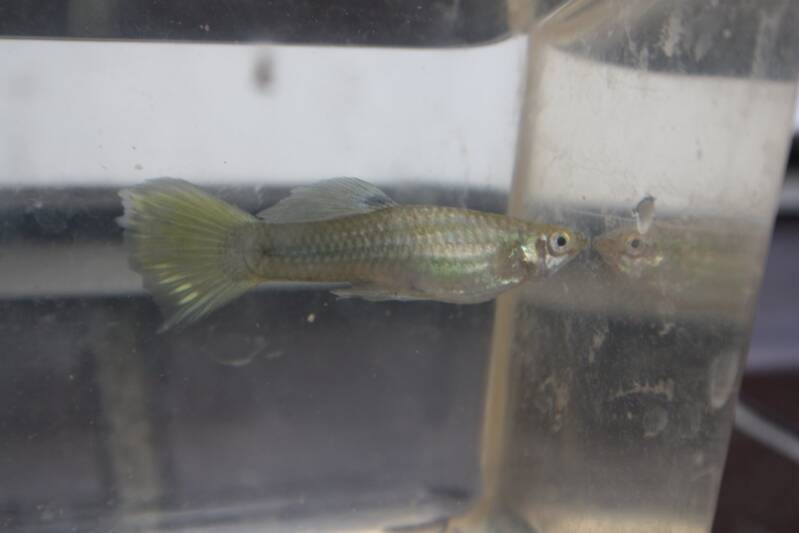
Another conscious hybridization is between Micropoecilia picta and Rio approuague wildguppy. Used a M.picta red male x a virgin Rio approuague female. The males that came out of that cross looked a bit different in pattern.

These offspring turned out to be fertile as well. But some characteristics of both species are still to be found in this crossbreed.
In 2017 I've started all over to create a hybrid between Micropoecilia picta x endler. This time I've selected virgin females of the Poecilia wingei "red chest" (Cumana) to crossbreed to a male Micropoecilia picta red.
The F1 offspring developed really well and were well build. What has become clear was that the males turned out to have a similar body shape as the Micropoecilia picta male but a color pattern that has similarities with the males of the red chest endler.
But the red coloration on the chest of these new males only showed up on the lower part of the chest unlike a regular red chest endler. Also more green (some even blue) could be noticed on the caudal penducle of most males. A monocle on both sides of the chest (like the red chest endler) and a peacock on both sides of the caudal (like the Micropoecilia picta) showed up on every male specimen. When it comes to the color pattern, the male hybrids are almost a cross-over (from the red chest endler). But the body shape heads more in the direction of the Micropoecilia picta. Also the sword pattern are shorter than those of a regular red chest endler.

The female offspring however were slender(just like Micropoecilia picta females) and showed a similar pointy nose which Micropoecilia picta females have. But looking at their scales, they resemble more to the Poecilia wingei females. Also these hybrids turned out to be complete fertile.

Above: Female offspring of the crossbreed Micropoecilia picta x Poecilia wingei "Red chest".
Below: Some male offspring of the crossbreed Micropoecilia picta x Poecilia wingei "Red chest".

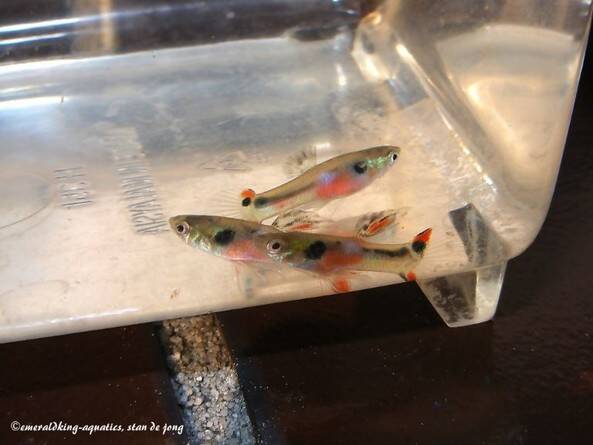
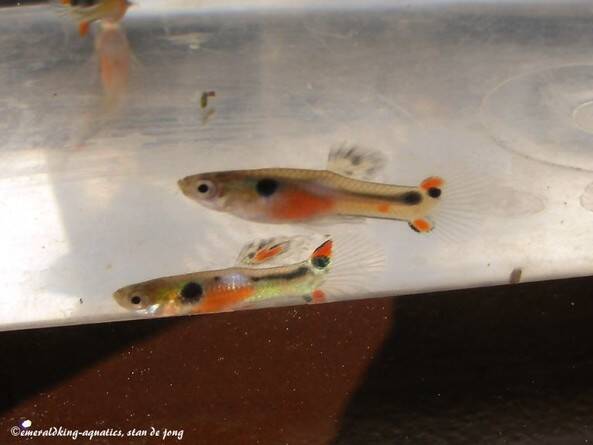
These attempts to crossbreed between Micropoecilia picta x Poecilia wingei or a crossbreed between Micropoecilia picta x Poecilia reticulata have been proven possible. And again, these hybrids are fertile by all means...
A wildtype male guppy developed in my mutt tank. When he grew, I've noticed that he had large pectoral fins. I assume that one or more of the mutts carried the Kalymma gene. And mated with a wildtype guppy in my mutt tank. All guppies and endlers that won't meet up the specific traits of their strain, will be culled and put in the mutt tank. In there they're allowed to crossbreed. The Kalymma gene is responsible for the large fin development (see Fancy guppy 1).
So, exceptional to see big ear wildtype guppy...
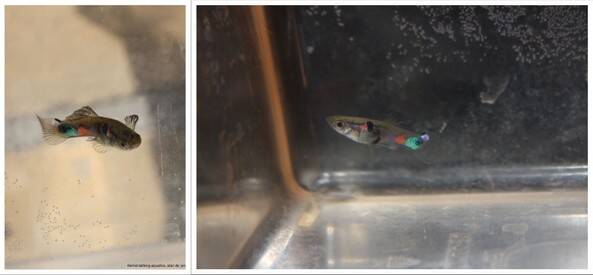
Above: An adult big ear wildtype guppy ♂
Natural mutations
In 2015 I had some fry born of the Limia tridens. I've noticed a pale looking fry between the normal grey striped fry. It turned out that a natural mutation took place for this single pale female fry turned out to be a blonde Limia tridens. It hardly showed some stripes on the body unlike the others.


In 2013 a small number of male fry within the japan blue guppy colony colored totally different than their siblings. Instead of japan blue, they turned into metallic grey-blue. With a hint of pink in them.

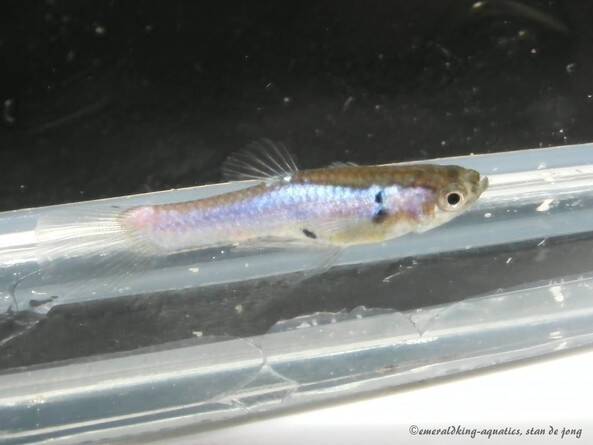
Back in 2016 a weird mutation took place with one of my Red scarlet endlers (Chili endler). One juvenile male turned not red, pink or magenta but copper colored. It also remained the only one of the whole batch.
In the picture below shows the copper colored male.
